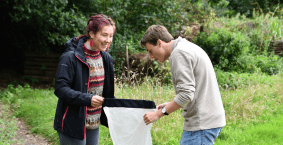Invertebrates in leaf litter and soil
Invertebrates in leaf litter and soil generally move by running or crawling, although some may also be able to fly. Be gentle when handling live animals.
Pitfall trap
Pifall traps are containers, such as glass jars and plastic cups, sunk into the soil for animals to fall into. They work for running or crawling invertebrates. Place a cover, raised on stones, above the trap to keep out the rain.
To avoid predatory animals such as spiders from eating the rest of the catch, you can place a small amount of washing-up liquid in water in the bottom of the trap to kill the invertebrates. Pitfall traps can be baited – for example, beer attracts slugs and snails, while fermenting fruit attracts flies.
Chemical irritants
Deep-burrowing earthworms can be brought to the surface by watering the ground with a dilute solution of potassium permanganate. A non-toxic alternative is a dilute solution of mustard powder in water.
Tullgren funnel
The Tullgren funnel is used to extract invertebrates from samples of soil or leaf litter brought back from the woodland to the lab. The sample is placed in a funnel above a perforated disc and the whole apparatus placed under a low-powered electric light bulb. The rise in temperature and the drying effect encourage the animals to move away from the source of heat, downwards through the holes in the perforated disc, into the funnel and so to the collecting vessel underneath. Leave the funnel for at least 2-3 days.

Secondary and Further Education Courses
Set your students up for success with our secondary school trips and courses. Offering excellent first hand experiences for your students, all linked to the curriculum.
Group Leader and Teacher Training
Centre-based and digital courses for teachers
Experiences for Young People
Do you enjoy the natural world and being outdoors? Opportunities for Young People aged 16-25.
